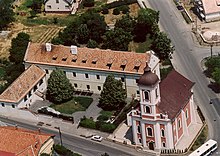Balatonalmádi
| Balatonalmádi | ||||
|
||||
| Basic data | ||||
|---|---|---|---|---|
| State : | Hungary | |||
| Region : | Central Transdanubia | |||
| County : | Veszprém | |||
| Small area until December 31, 2012 : | Balatonalmádi | |||
| District since 1.1.2013 : | Balatonalmádi | |||
| Coordinates : | 47 ° 2 ' N , 18 ° 1' E | |||
| Area : | 49.89 km² | |||
| Residents : | 9,062 (Jan 1, 2011) | |||
| Population density : | 182 inhabitants per km² | |||
| Telephone code : | (+36) 88 | |||
| Postal code : | 8220 | |||
| KSH kódja: | 05838 | |||
| Structure and administration (as of 2020) | ||||
| Community type : | city | |||
| Mayor : | Lajos Kepli (independent) | |||
| Postal address : | Széchenyi sétány 1 8220 Balatonalmádi |
|||
| Website : | ||||
| (Source: A Magyar Köztársaság helységnévkönyve 2011. január 1st at Központi statisztikai hivatal ) | ||||


Balatonalmádi [ ˈbɒlɒtonɒlmaːdi ] (formerly Almádi ) is a Hungarian city in the district of the same name in Veszprém County . It is known as a bathing and health resort . The districts of Vörösberény (since 1971), Budatava and Káptalanfüred belong to the city.
Geographical location
Balatonalmádi is located on the northeastern bank of Lake Balaton , ten kilometers southeast of the Veszprém county seat . Neighboring communities are Balatonfűzfő , Alsóörs , Felsőörs and Szentkirályszabadja .
history
At the beginning of the 20th century, Balatonalmádi was a well-known health resort with sanatoriums, Kneipp facilities and air baths, in which Arnold Rikli's method was practiced. The place was officially declared a seaside resort in 1961.
Archaeological finds from the Bronze Age suggest that the place was settled 8,000 years ago. The small town is located in the northeast corner of Lake Balaton and is surrounded to the west and north by gently sloping hills. Through these hills - e.g. B. the Öreghegy (German "Old Mountain") - Balatonalmádi is protected from the prevailing winds in summer.
Balatonalmádi has a little over 8,000 permanent residents, although the number of residents can rise to over 20,000 in the summer months. The tourism is now the main source of income.
Balatonalmádi is divided into four districts: Vörösberény , Balatonalmádi and Káptalanfüred , or Budatava , which formerly belonged to Vörösberény administratively .
Attractions
The construction in Balatonalmádi is characteristic of the area: red natural sandstone, which can be found here, is often used. Some of the old villas and spa houses are still there on Öreghegy, but only a few of these buildings can be found in the town center.
Most of the old inns in the village are no longer there. The Liget coffee house in the Alter Park am Strand was reopened in the 1990s and is now a family- run café again . In Öreg-Park there is a beach promenade with a bandstand and old trees. On the beach you come to the entrance of the largest lido on the north bank: the Wesselényi lido, which has existed in its current form since 1953.
On the Öreghegy there is the Óvári lookout tower, built in 1900, which offers a view of the city and the surrounding area. In Vörösberény there is the Wesselényi lookout tower, from which you can see all the way to Tihany on nice days .
The parish church of Balatonalmádi, which bears the name of St. Emmerich , was built in 1930. The Szent Jobb Chapel of this church was named after a relic : a piece of the right arm (Szent Jobb) of the first King of Hungary , Stephen I , is kept here.
The reformed fortified church in Vörösberény dates from the 12th to 13th centuries and combines three styles: the foundation walls are Romanesque , the windows are Gothic , and the interior design is baroque .
In the old town hall (Városháza) , which also housed shops around 1900, there is now a music school and a bakery . The new town hall was built in place of a building damaged by an earthquake in 1985 and is located in the center of the village, not far from the most famous hotel in Almádi (formerly Aurora, since 2004 Ramada ), which is the tallest building in the city.
education
In the city there are two kindergartens , two elementary schools and a bilingual (English-Hungarian-speaking) high school , where native speakers teach the subjects in English . The grammar school was established in the 1980s as the first bilingual grammar school in Hungary. The high school also has a modern boarding school . In the Vörösberény district, the financial investor György Soros financed the construction of a new elementary school. The city also has a cultural center with a modern library and multi-purpose rooms .
traffic
Balatonalmádi has a train station on the Székesfehérvár – Tapolca railway line , where express trains from Budapest also stop. The main road No. 71 leads through the city , from which the country roads No. 7217 and No. 7218 branch off inland. There are also ship connections to other places on Lake Balaton.
Town twinning
Balatonalmádi maintains partnerships with Kalajoki (Finland), San Michele al Tagliamento (Italy), Eggenfelden (Germany) and Nyitragerencsér (Slovakia).
Sons and daughters
- Ferenc Szoldatits (born November 29, 1820 in Vörösberény, † January 25, 1916 in Rome), painter, Nazarene
Web links
- Official website ( Hungarian )
- Balatonalmádi near Magyarország helységnévtára (Hungarian)
- Almádi in A Pallas nagy lexikona (Hungarian)
- Aerial photos of Balatonalmádi
Individual evidence
- ↑ Helyi önkormányzati választások 2019 - Balatonalmádi (Veszprém megye). Nemzeti Választási Iroda, October 13, 2019, accessed June 8, 2020 (Hungarian).
- ^ Website Balatonalmádi


